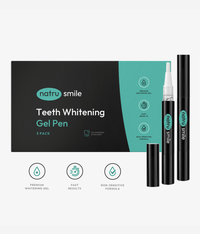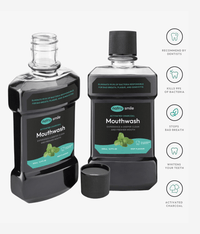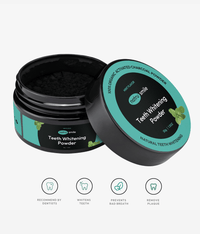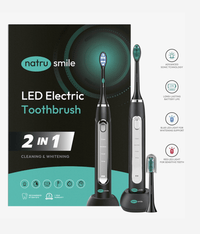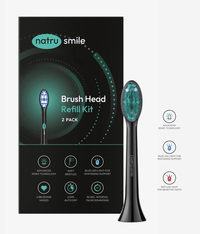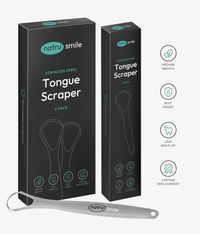
All products are certified by dental expert Dr. Greg Grillo
Teeth whitening has rapidly gained popularity as a solution for enhancing the natural color of teeth, providing brighter, more appealing smiles.
At-home teeth whitening has become an increasingly attractive option for individuals seeking convenience, affordability, and a more comfortable experience for cosmetic dentistry.
In this detailed guide, we'll compare the effectiveness of at-home teeth whitening treatments to in-office whitening procedures, delve into various treatment options available, assess the benefits and risks associated with at-home methods, and address common questions that may arise. After reading, you’ll be able to find the right teeth whitening option for you.
Effectiveness Of At-Home Teeth Whitening Vs. In-Office Whitening
At-home teeth whitening, though convenient, may not offer the same immediate and dramatic results as professional in-office treatments. However, with consistent and proper use, at-home methods still yield impressive outcomes with a noticeable improvement in the teeth's color. To comprehensively evaluate the effectiveness of at-home teeth whitening, we'll compare it to in-office whitening in terms of the following factors:
- Timeframe
- Degree of Whitening
- Longevity of Results
Exploring Various At-Home Teeth Whitening Treatment Options
There is a wide array of at-home whitening treatments available on the market today, each with its benefits and drawbacks. To help you choose the most suitable method, we'll discuss the following options in detail:
Weighing The Benefits And Risks Of At-Home Teeth Whitening
Although the prospect of whitening your teeth at home may seem appealing, it's essential to weigh the advantages and potential risks before diving into any treatment. We'll outline the benefits and examine possible teeth whitening side effects, addressing concerns such as tooth sensitivity, gum irritation, and enamel damage.
Do Home Teeth Whitening Kits Really Work?: A Comprehensive Analysis
Many people wonder if at-home teeth whitening kits genuinely deliver the results they promise. The answer is yes - these kits are effective in brightening your smile when used correctly. However, it's important to keep in mind that results vary significantly from one individual to another depending on several factors.
Factors That Influence The Effectiveness Of Home Teeth Whitening Kits
- Quality Of The Product: Not all at-home whitening kits are created equal. The effectiveness of these kits depends largely on the quality of the product itself. Higher-quality kits typically contain a more potent teeth whitening agent and are more likely to offer better results than lower-quality alternatives.
- Degree Of Tooth Discoloration: The starting shade of your teeth will also have an impact on the final results. Individuals with mild to moderate discoloration are more likely to see significant improvements in the brightness of their teeth compared to those with severe or deeply ingrained stains.
- User's Discipline And Consistency: The effectiveness of a teeth whitening kit is also heavily reliant on the user's ability to follow the provided instructions diligently and consistently. Skipping sessions or not using the product for the recommended teeth whitening duration diminishes the overall impact of the whitening process.
To sum up, at-home teeth whitening kits work well when used correctly, but it's crucial to select a reliable, high-quality product and ensure you're consistent in following the directions. It's also crucial to manage expectations and recognize that results will vary among individuals based on the specific factors mentioned above.
Most Effective At-Home Teeth Whitening Options With Whitening Kits
In recent years, the demand for tooth whitening solutions has skyrocketed, leading to a wide variety of teeth whitening products flooding the market. But, it's essential to remember that these products offer varying levels of efficacy and not all of them are created equal. Therefore, in this section, we'll dive deeper into the most effective at-home teeth whitening options, including using whitening kits, to assist you in making the best choice for your dental care needs.
Before we proceed, it's crucial to understand that the effectiveness of at-home teeth whitening options largely depends on several factors, such as the cause of tooth discoloration, the active ingredients in the whitening products, and how closely you follow the manufacturer's instructions.
Top At-Home Teeth Whitening Options
- Whitening Toothpaste: One of the easiest ways to incorporate teeth whitening into your daily routine is by switching to a whitening toothpaste. Most of these kinds of toothpaste contain mild abrasives that gently polish the surface of your teeth and help remove surface stains.
- Whitening Strips: Whitening strips are thin, flexible strips coated with a whitening gel that contains hydrogen peroxide or carbamide peroxide. You place the strips on your teeth for a specified amount of time, usually between 30 minutes to an hour, each day for a week or two to achieve noticeable results.
- Whitening Gels And Trays: Whitening gels, or tray-based systems, involve using custom-fitted dental trays filled with a whitening gel, which typically contains a higher percentage of peroxide than over-the-counter options. You'll need to wear the trays for a specified period daily for a week or two, depending on the extent of tooth discoloration and the desired level of whitening.
- At-Home Led Or UV Whitening Kits: These kits, sometimes called “tooth bleaching”, combine the use of a whitening gel with LED or UV light exposure to speed up the whitening process. It usually consists of a mouth tray filled with gel and a light source that you hold over your teeth for a specified time.
When considering any teeth whitening option, it's crucial to consult your dentist for personalized recommendations based on your oral health and unique needs. Your dentist will provide you with advice regarding teeth whitening safety and effectiveness for each product.
In conclusion, there are several at-home teeth whitening options available to you, each with its own set of benefits and drawbacks. By exploring these options and consulting with your dentist, you'll be better equipped to make an informed decision about the most effective solution for your individual needs.
Teeth Whitening Toothpaste
Teeth whitening toothpaste is a widely available and commonly used solution for those looking to improve the appearance of their teeth. These types of toothpaste contain a combination of mild abrasives and whitening agents, which work in tandem to remove surface stains from the teeth. This method of teeth whitening is considered to be one of the gentlest options, making it the foremost choice of teeth whitening for sensitive teeth or gums.
However, it is essential to note that the results achieved with teeth whitening toothpaste are generally subtle and may take an extended period to become noticeable. This is because toothpaste primarily targets surface-level discoloration, whereas other methods may penetrate deeper into the tooth enamel. If you decide to use teeth whitening toothpaste, be patient and consistent with your brushing habits to achieve the best results.
Teeth Whitening Gel
For those seeking a more intense and rapid teeth whitening treatment, using a whitening gel at home might be the perfect solution. These gels are known for their effectiveness in breaking down and lifting stains, thanks to their main active ingredient - peroxide. With the potential to deliver visible results within just a few days of application, teeth whitening gels have gained popularity among many people.
However, it's crucial to exercise caution when using these gels, as high concentrations of peroxide may result in tooth sensitivity and gum irritation. To avoid such side effects, always follow the manufacturer's instructions carefully, and consider starting with a lower peroxide concentration if you're new to teeth whitening gels or have sensitive teeth. It's always a good idea to consult your dentist for personalized advice and recommendations based on your unique dental needs and desires.
Teeth Whitening Toothbrush
Teeth whitening toothbrushes are specifically designed to target and remove surface stains on teeth, thanks to their unique bristle configurations. These specialized bristles work to effectively lift and remove stains from the tooth's surface, making the toothbrushes ideal for those seeking a brighter smile. For more noticeable results, you should pair a teeth-whitening toothbrush with a whitening toothpaste that contains mild abrasives or enzymes to break down and remove stains.
However, it's important to note that while teeth-whitening toothbrushes aid in improving the brightness of your smile, the degree of whitening achieved may be limited compared to professional methods, such as in-office laser whitening treatments.
Teeth Whitening Electric Toothbrush
Electric toothbrushes are generally considered to be more effective in removing stains and plaque than their manual counterparts. This is due to their powered mechanisms which allow for more efficient and thorough cleaning of the tooth's surface. Some electric toothbrush models boast specific teeth whitening modes that are tailored to better target stains and discoloration.
Nonetheless, it is essential to recognize that, similar to manual teeth-whitening toothbrushes, electric toothbrushes may not deliver results as dramatic as those achieved through professional teeth-whitening treatments. They do help to maintain and enhance the results of such treatments, however.
Teeth Whitening Mouthwash
Teeth-whitening mouthwashes typically contain hydrogen peroxide, a common bleaching agent, which aids in the removal of tooth stains. Used in conjunction with regular brushing, these mouthwashes may provide an added level of protection against stains and overall discoloration.
However, it is important to remember that the contact time between the mouthwash and your teeth is relatively brief, usually only a minute or two. Consequently, the whitening effect from using a teeth-whitening mouthwash might not be as noticeable and significant as you might hope for. In terms of a more substantial and long-lasting whitening effect, you may want to consider other treatment options, such as professional whitening sessions.
Different Teeth Whitening Methods: Pros And Cons
In this section, we'll discuss various teeth whitening methods available in the market, including their advantages and potential drawbacks. Armed with this information, you’ll make an informed decision about which method best suits your needs and preferences.
Teeth Whitening Strips
Teeth whitening strips are thin, flexible plastic (polyethylene) strips coated with a peroxide-based whitening gel. These strips, designed to adhere to the surface of your teeth, need to be applied daily for 30 to 60 minutes, depending on the product instructions. Typically, you see visible results within a week of using the strips.
Pros:
- Easy to use and apply
- Produce visible results within a short period
- Relatively affordable compared to in-office treatments
Cons:
- Improper application leads to gum irritation and tooth sensitivity
- May not be as effective on severely discolored teeth
- Some users may experience uneven whitening
Teeth Whitening Powder
Teeth whitening powders, like activated charcoal powder, have gained popularity as a homemade and natural teeth whitening option. Activated charcoal is known for its adsorptive properties, allowing it to bind with and remove certain surface stains on the teeth when rubbed gently onto them.
Pros:
- Natural and chemical-free alternative
- Are effective in removing some surface stains
- Available over-the-counter and easy to use
Cons:
- The abrasive nature may damage tooth enamel if used excessively
- May not remove deep or more resistant stains
- Does not usually produce dramatic or instant results
Teeth Whitening Pen
Teeth whitening pens are compact, portable pens that contain a peroxide-based whitening gel. Similar to teeth whitening strips, the gel inside the pen is applied directly onto the surface of your teeth. The convenience of the pen allows for easy touch-ups and on-the-go whitening.
Pros:
- Convenience and portability make it suitable for on-the-go use
- Simple application process
- Are relatively affordable
Cons:
- Uneven gel distribution may lead to inconsistent results
- May not be as effective as other teeth-whitening methods
- Not suited for individuals with highly sensitive teeth
Now that we have discussed different teeth whitening methods in detail, it's essential to choose the most suitable option based on your specific dental condition, preferences, and budget. Always consult with your dentist before attempting any whitening treatments, as they provide personalized guidance and recommendations based on your oral health requirements.
The Advantages Of Take-Home Teeth Whitening
Maintaining a bright, white smile is a goal for many individuals. As a result, there has been a surge in the popularity of take-home teeth whitening kits as an effective and convenient alternative to professional teeth whitening treatments. In this section, we'll explore some of the main advantages of using take-home teeth whitening kits, focusing on their affordability, ease of use, and overall effectiveness.
Affordability: The Cost Doesn't Break The Bank
At-home teeth whitening cost is one of the most significant advantages of take-home teeth whitening kits. Compared to in-office professional teeth whitening treatments, which range from hundreds to thousands of dollars depending on the procedure, at-home whitening kits are available at a fraction of the cost. Generally, the cost is around $20 to over $300, depending on what kit you choose or if you get it from a dentist. This affordability allows individuals with varying budgets to enjoy the benefits of white teeth without putting too much financial strain on their wallets.
In addition to the lower initial cost, many take-home whitening kits also offer refills or replacement components, which means that individuals continue enjoying the brightening effects of their whitening treatment without investing in an entirely new kit each time.
Convenience And Flexibility: Whiten Your Teeth At Your Own Pace
Take-home teeth whitening kits provide users with the flexibility to whiten their teeth on their own schedule and in the comfort of their own homes. This means that individuals don't need to make appointments and potentially take time off work or rearrange their schedules to accommodate in-office treatments.
Additionally, take-home whitening kits often have several applications, allowing users to tailor their treatment to their specific needs and desired tooth shade. This level of personalization helps ensure that individuals achieve the desired level of whitening without over-bleaching their teeth, which leads to increased sensitivity and other issues.
Effectiveness: Noticeable Whitening Results
While professional teeth whitening treatments may provide faster results, many take-home kits still offer noticeable and significant whitening effects. These kits often utilize similar active ingredients, such as hydrogen peroxide or carbamide peroxide, which work to break down stains on the tooth's surface and brighten the tooth's color.
By diligently following the included instructions and maintaining a consistent whitening schedule, individuals may see noticeable improvements in their tooth color over time. Furthermore, consistent at-home maintenance may help prolong the results of whitening treatments, ensuring a bright smile for an extended period.
Convenient And User-Friendly
One of the most appealing features of at-home teeth whitening kits is their convenience. By using a high-quality whitening kit in the comfort and privacy of your own home, you avoid the hassle of scheduling dental appointments or taking time off work. This not only frees up your schedule for other important tasks and responsibilities, but it also allows you to maintain your dental hygiene and appearance on your own terms.
Whiten Your Smile According To Your Personal Timetable
The flexibility of at-home teeth whitening kits extends to the ability to tailor the treatment process to suit your individual needs and preferences. Unlike in-office treatments, which are rigid and restrictive, at-home teeth whitening kits empower you to monitor your progress and adjust the frequency and consistency of use as necessary. This means that you control factors such as the intensity of your treatment or the duration of your whitening sessions, ultimately achieving your desired level of brightness without having to adhere to a one-size-fits-all schedule.
By taking charge of your own teeth whitening journey, you customize your treatment plan to achieve the most optimal and satisfying results. In turn, this leads to increased self-confidence and satisfaction with the appearance of your smile, as well as improved dental health overall.
Consider a situation where you have an important event approaching and you're looking to improve your smile. In such a scenario, a take-home teeth whitening kit is an effective and convenient solution. These kits allow you to begin the treatment process in the comfort of your own home and achieve visible results within a relatively short time frame.
To help you understand the process better, let's break down how the take-home teeth whitening kit process works.
First, you'll schedule a consultation with your dentist who will evaluate your teeth and recommend the most suitable whitening method based on your individual needs. Next, they'll provide you with custom-fitted dental trays that are designed to hold the teeth-whitening gel in place. The dentist will also supply you with the teeth whitening gel, usually containing a specific concentration of hydrogen peroxide or carbamide peroxide, which acts as the bleaching agent.
When you're ready to start the treatment, you'll apply a small amount of gel to the trays, then place the trays onto your teeth, making sure they fit snugly. The length of time you'll need to wear the trays depends on the strength of the gel and your dentist's recommendations, but it usually ranges from 30 minutes to a few hours per day. As you continue the treatment, you'll notice your teeth gradually becoming whiter and brighter over time.
Not only is a take-home teeth whitening kit an excellent way to improve your smile for upcoming events, but it also offers the convenience of undergoing the treatment at your own pace, while still achieving professional-level results.
Risks Of Teeth At-Home Whitening Kits
At-home teeth whitening kits have surged in popularity in recent years, as people seek convenient and affordable ways to achieve brighter smiles. However, there are potential risks associated with these products that you should be aware of before considering using them. In this section, we will discuss some of the potential hazards related to at-home teeth whitening kits, which include damage to tooth enamel and gums, as well as provide recommendations for avoiding such negative outcomes.
Potential Damage To Tooth Enamel From Teeth Whitening Kits
One of the primary concerns with some at-home teeth whitening products, specifically those that contain abrasive ingredients, is the potential for damaging tooth enamel. When these products are used improperly or excessively, the abrasive nature of the ingredients wears down the tooth's enamel, making your teeth more susceptible to decay, sensitivity, and even more discoloration. Ensuring you follow the product's instructions carefully and avoid excessive use helps minimize these risks.
Potential Harm To Gums From Teeth Whitening Kits
Another concern with at-home teeth whitening gels and strips is the possibility of causing damage to your gums. When the whitening gel or strip comes into contact with the gums for extended periods or in high concentrations, it leads to gum irritation, inflammation, and even burns. This is particularly concerning for those with existing gum diseases (such as periodontal disease) or those who have dental restorations such as crowns or fillings.
To minimize the risk of gum damage, be sure to follow the product instructions carefully and avoid using more of the whitening product than necessary. If you experience persistent discomfort or have previous dental health issues, consult with a dental professional before using at-home teeth whitening kits.
By being aware of these risks and taking the recommended precautions, you'll be better equipped to make an informed decision about whether at-home teeth whitening is the right choice for you.
Teeth Whitening Kits May Cause Mouth Infections
At-home teeth whitening kits have gained immense popularity thanks to their convenience and affordability. However, it's essential to recognize that, if not stored and maintained correctly or shared among multiple users, these kits may put individuals at risk of introducing harmful bacteria and causing mouth infections. Infections result in pain, gum inflammation, and even tooth loss if left untreated.
It's crucial to follow storage and maintenance guidelines provided by the manufacturer and avoid sharing your teeth-whitening products with others. By exercising caution, you'll minimize the chances of experiencing any unwanted side effects.
There are a lot of questions that go along with teeth whitening, especially when you’re doing it yourself at home, so let’s take a look at the answers to some questions you may still have about the process.
How Can I Get White Teeth In 1 Day?
Having a bright white smile often takes years to achieve, but teeth whitening at home is an effective way to get whiter teeth in as little as one day! Here’s how you may be able to get white teeth in 1 day.
The first step is to make sure your mouth is clean and healthy before beginning any type of teeth-whitening process. This means brushing and flossing twice daily, using an antibacterial mouthwash, and avoiding foods that may stain or discolor your teeth such as coffee, tea, and red wine.
Once your mouth is healthy, you start with the actual whitening process. There are several products available for teeth whitening at home such as toothpaste and gels that contain bleaching agents like hydrogen peroxide or carbamide peroxide. These are applied directly to your teeth using a brush or tray and left on for up to 30 minutes before being rinsed off.
Another option is to use an LED light device that emits blue-light wavelengths designed to accelerate the whitening process. The light helps activate the bleaching agent in many brands of toothpaste and gels, so you get results faster.
If you want to take it a step further and achieve even whiter teeth in one day, there are some more extreme methods of whitening available. These include using strips that contain higher concentrations of bleaching agents or having your dentist apply professionally-formulated whitening trays directly to the surface of your teeth. This method is typically done in-office and requires several treatments over the course of several weeks.
Is There A Way To Whiten Teeth In 3 Minutes?
Although professional treatments are still available, there are now a number of simple methods which are used at home to make teeth whiter in 3 minutes. The key lies in understanding what causes discoloration in the first place and using products specifically designed for teeth whitening as well as some everyday items found around the house.
The most common cause of teeth discoloration is due to staining from food and beverages such as coffee, tea, red wine, and other dark-colored drinks. Smoking also contributes to tooth discoloration. Over time, these staining particles build up on the enamel surface and become lodged in microscopic pits or cracks that cannot be removed by brushing alone. Fortunately, there are a number of products available that help whiten teeth quickly at home without any discomfort or sensitivity.
Products such as whitening strips, gels, or trays are designed to break down stains on the enamel surface and work best when used over multiple applications. These products are available at most drug stores, pharmacies, or online retailers.
In addition to these whitening products, there are also some natural remedies that are used to help whiten teeth in as little as three minutes. Baking soda is one of the most popular options and has been proven to help reduce discoloration on the enamel surface when combined with a few drops of hydrogen peroxide. The paste should be applied directly onto the teeth using a toothbrush and left for several minutes before being rinsed off with water.
Another option is to use apple cider vinegar, which has natural antibacterial and whitening properties. This is used as a mouthwash by combining one part apple cider vinegar with two parts water before rinsing the mouth out for around 30 seconds.
It’s important to remember that while these at-home remedies may help reduce discoloration on the enamel surface they will not be able to change the shade of teeth permanently. For the best results, it is always recommended to visit a dentist for professional teeth whitening treatment.
What Is The Most Effective Product To Whiten Teeth?
If you're looking for the most effective at-home teeth whitening product, consider opting for teeth whitening strips or trays with a peroxide-based gel. When used correctly and as per the instructions, these products tend to provide faster and more noticeable results compared to alternative methods such as whitening toothpaste or mouthwash.
Peroxide-based gels work by penetrating the tooth enamel and breaking down the stains that cause discoloration. However, it's worth noting that these treatments may not be suitable for everyone, especially those with sensitive teeth or gums. Always consult your dentist before starting a whitening treatment to ensure it's the best option for you.
Is At-Home Teeth Whitening Effective?
When used correctly and consistently, at-home teeth whitening products are very effective. They help to improve the overall brightness of your smile and remove mild to moderate stains. However, it's important to manage expectations, as the degree of effectiveness and speed at which results are achieved may vary from person to person and depend on the specific product used.
Some contributing factors to the effectiveness of at-home teeth whitening include the severity of stains, the individual's dental hygiene habits, and the product's concentration of active ingredients. It's important to keep in mind that at-home teeth whitening solutions may not yield the same dramatic results as in-office dental treatments – but they certainly make a visible difference when used appropriately.
How Can I Get Rid Of White Spots On My Teeth?
White spots on teeth are often caused by poor dental hygiene habits or inadequate brushing and flossing. When plaque builds up on the enamel surface, it leaves behind white patches that are difficult to remove without professional help. As an effective remedy, many dentists recommend using hydrogen peroxide, a natural whitener, to help get rid of white spots and keep your teeth looking their best.
The use of hydrogen peroxide for oral care is very simple. It comes in a variety of strengths, so be sure to find one that is diluted to around 3%. To begin, simply dip a cotton swab into the solution and dab it onto any visible white patches on your teeth. Allow the solution to sit for up to two minutes before rinsing your mouth with water. Repeat this process once daily until you notice an improvement in the appearance of your teeth.
What Is The Difference Between In-Office And At-Home Teeth Whitening?
While both methods involve using hydrogen peroxide to bleach teeth, there are some key differences that will help make the decision of at-home whitening vs in-office easier for you.
In-office teeth whitening treatments are often the more expensive option, but they also offer more noticeable results in less time. The hydrogen peroxide used for this type of treatment is usually a much higher concentration than at-home products, which means it penetrates deeper into the enamel and removes stubborn stains that other methods may not be able to reach. In addition, dentists typically apply a protective gel over your gums before starting the procedure to ensure that you don’t experience any irritation or sensitivity during or after treatment.
At-home teeth whitening kits use lower concentrations of hydrogen peroxide and take longer to produce results. But, they are often more affordable and convenient for those who don’t have the time or money to visit a dentist’s office. These kits usually include strips, trays, or pens that you apply in the comfort of your bathroom.
Can I Whiten My Yellow Teeth with At-Home Teeth Whitening Products?
At-home teeth whitening products are a popular way to remove surface stains and brighten the overall appearance of your teeth. These products are designed to help combat discoloration, so they are often an effective way to get rid of yellow teeth. However, the success of at-home whitening treatments depends on the severity and cause of the discoloration. For moderate yellowing, at-home teeth whitening products may be sufficient but for more severe cases, professional dental cleaning treatments might be necessary.
Keep in mind that enamel erosion, dentin exposure, and other dental issues contribute to persistent yellow stains that may not be effectively addressed by at-home products alone.
How Does Smoking Impact Teeth Whiteness?
Smoking and dental health are very intertwined, and it is well-known that smoking can have a negative impact on your teeth. The tar and nicotine in cigarettes cause discoloration of the enamel layer of the teeth, as well as staining between the teeth. Without proper care, this permanent yellowing or discoloration worsens over time.
One way to reduce staining caused by smoking is through regular brushing with hydrogen peroxide-based toothpaste. Hydrogen peroxide has been used for years to whiten teeth due to its bleaching properties. It works by breaking down certain molecules that are responsible for causing stains on the enamel of your teeth.
What are Some Common Mistakes When Whitening Teeth At Home?
- Not Following Instructions: Many individuals neglect to properly read and follow the directions provided by the manufacturer, leading to poor results or potential harm to their teeth and gums. Carefully reading and following the instructions ensures that the whitening process is safe and effective.
- Overusing Teeth Whitening Products: Excessive use of whitening products damages the enamel and causes increased tooth sensitivity. To avoid these issues, it's crucial to follow the recommended usage guidelines and seek professional advice if you're uncertain about your specific needs.
- Using Expired Products: Whitening agents in these products degrade over time, rendering them less effective or potentially harmful to your teeth. Always check the expiration date before using any teeth whitening product.
- Poor Dental Hygiene: Regularly brushing and flossing your teeth is essential for maintaining a healthy and bright smile. Teeth whitening products only do so much if your teeth are plagued by plaque and tartar buildup. Maintaining proper oral hygiene helps enhance the results of your teeth whitening efforts.
- Unrealistic Expectations: It's important to keep your expectations realistic. Over-the-counter products are generally less potent than professional treatments and some types of discoloration may not respond well to at-home treatments. Patience and understanding that results vary from person to person will help you make informed choices and maintain a positive outlook.
By avoiding these common mistakes, you improve the effectiveness of your at-home teeth whitening efforts and achieve a whiter, more radiant smile.
The Bottom Line
In conclusion, at-home teeth whitening treatments offer an affordable, convenient, and effective solution for those looking to brighten their smile, provided that they are used correctly. It's essential to choose a product that best suits your specific needs, follow the included instructions diligently, and maintain good dental hygiene for the best possible results.
As always, it is strongly advised to consult with a dental professional when contemplating any teeth whitening treatment – they provide personalized guidance and advice tailored to your situation.
Remember, a thorough understanding of the process, potential risks, and safety measures are key to achieving the best results on your path to a more radiant smile.


